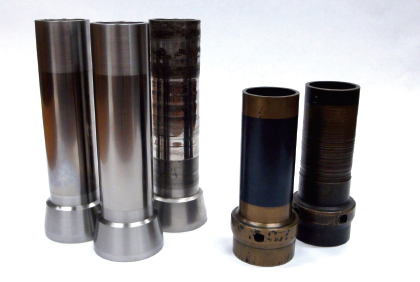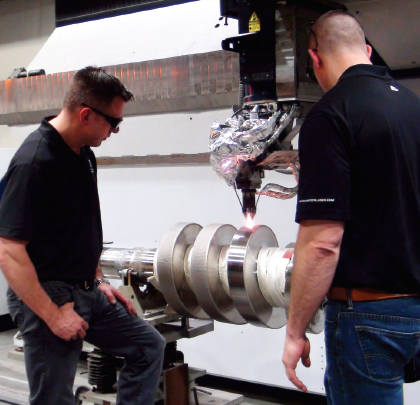Laser metal deposition on pump screw; Dan Hayden (left), Tim Wetherbe (right)
Typical weld characteristics are a single layer deposit thickness of around 0.04 inches, a heat affected zone of less than 0.01 inches, a bead width (determined by the laser and optics used) of between 0.125 to 0.5 inches, and, most importantly, substrate temperatures well under 1,000 degrees Fahrenheit (537 degrees Celsius). This means that fully or mostly-machined pump screws, impellers, plungers, liners, and housings can be protected with a hard-wearing, impermeable corrosion barrier—without losing critical design features or sacrificing close tolerances.
Of course, it is always best to perform final machining and finishing after the overlay is applied. Moreover, local repair or improvement of existing finished hardware is possible and more practical. Even salvage of damaged and mis-machined components is common using this technique.
Laser metal deposition still provides protection comparable with more traditional spray-and-fuse coatings, with hardness, wear rates and chemical composition virtually equivalent to current practice. The key advantages of the process over traditional application methods are as follows:
PRECISE APPLICATION
The laser machine tool will apply hardfacing only where it is programmed; overspray, bleedout and feathering common to older spray methods are essentially removed. The relative crudeness of deposition control with spray-and-fuse often meant that hardface application went well beyond the areas where the protection was required, in order to ensure that there was sufficient material for proper fusing. The ability to program the deposition allows weld applicators and engineers to work closely together to place protection where it is needed and avoid unnecessary cost, time, and distortion.
BETTER ADHESION
Laser deposition creates an overlay that is fully welded to the substrate, with a typical dilution zone of 0.005 inches or so. Separation of the overlay from the substrate is practically impossible, even in very rough service environments. By contrast, variabilities in the torch or furnace fusing process can unexpectedly create regions within the overlay that are fully consolidated, but also slightly separated from the base material.
REDUCED HEATING
Tighter and more concentrated heat input at the weld zone eliminates the need for raising the entire pump component to high temperature during fusing. While preheating is used with some hardfacing materials, preheating temperatures will typically be well under 1,000 degrees Fahrenheit (537 degrees Celsius), compared with 1,200 to 1,500 degrees Fahrenheit (648 to 815 degrees Celsius) with torch or furnace processing. Less heat input equates to reduced processing time, lower distortion and, ultimately, lower cost per part.
IMPROVED UNIFORMITY
Gravity and uneven heat flow during torch and furnace fusing can cause sprayed coatings to flow and shift when the material reaches liquidus. Blisters, pores and holidays can form unintentionally, and the resulting thinned areas may leave insufficient material for cleanup during finish grinding. Since the laser process will apply a uniform bead thickness over the entire clad area, such unevenness is eliminated, and the rejection rate per order is substantially improved.

Worn and restored pump sleeves; carbide (left), chrome oxide (right)
OPERATOR TECHNIQUE
As with most welding processes, much of the success of fusing work is due to the technician’s skill and craftsmanship, which are only developed over time. An aging and retiring workforce and a noticeable decrease in the average number of years younger workers are remaining on the job has left many coating providers with fluctuating experience levels and greater potential for varying overlay quality. Most laser equipment is fully-automated, programmable and repeatable one job to the next, from month to month and year to year.
As pumping challenges continue to grow and unit up-time becomes more and more critical, maximizing component service life with protective surfacing will expand by necessity. Many of the industry’s time proven methods will continue to perform reliably, as they have for more than fifty years. The ability of technology to simplify, improve and reduce the cost of quality suggests that laser technology will provide a powerful new capability to OEMs, engineers and end users. Whether it is retrieving equipment that had previously been pegged as scrap or overcoming an engineering challenge that was once too costly or too complex, laser technology may be the solution you’ve been looking for.
About the author:
Dan Hayden is president of Massachusetts-based laser cladding and thermal spray service provider Hayden Corporation. He also serves as secretary/treasurer to the ASM International Thermal Spray Society, and executive officer to the International Thermal Spray Association. Hayden Corporation is a full-service, ISO 9002-2008 registered company providing thermal spray coatings, laser cladding, spray and fuse coatings, and more. For more information, visit www.haydencorp.com.
_______________________________________________________
MODERN PUMPING TODAY, May 2018
Did you enjoy this article?
Subscribe to the FREE Digital Edition of Modern Pumping Today Magazine!
![]()


